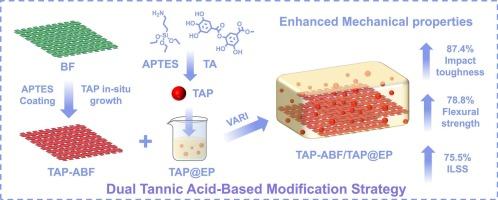Dual tannic acid-based modification strategy for enhanced mechanical properties of basalt fiber/epoxy composites
IF 8.1
2区 材料科学
Q1 ENGINEERING, MANUFACTURING
Composites Part A: Applied Science and Manufacturing
Pub Date : 2025-10-06
DOI:10.1016/j.compositesa.2025.109345
引用次数: 0
Abstract
Poor interfacial adhesion between basalt fibers and epoxy resin significantly limits the mechanical performance of basalt fiber/resin composites. However, current modification methods with high interfacial property enhancement involve harsh experimental conditions and expensive modifiers. In this study, a mild dual directional modification strategy is proposed, utilizing a tannic acid-based modifier TAP that simultaneously modified the resin and basalt fiber, and the dual directionally modified composites TAP-ABF/TAP@EP is prepared. This approach not only improves interfacial adhesion but also promotes stress dispersion and energy dissipation within the composites, leading to a substantial enhancement in mechanical properties. Compared with unmodified BF/EP, the interfacial shear strength, interlaminar shear strength, flexural strength and impact strength of TAP-ABF/TAP@EP were improved by 97.5%, 75.5%, 78.8% and 87.4%, respectively. Furthermore, the mechanisms of the enhanced interfacial adhesion and mechanical properties were thoroughly investigated. This work provides a simple yet effective bidirectional modification strategy, offering a promising pathway for developing high-performance basalt fiber/epoxy composites.

增强玄武岩纤维/环氧复合材料力学性能的双单宁酸改性策略
玄武岩纤维与环氧树脂的界面附着力差,严重限制了玄武岩纤维/树脂复合材料的力学性能。然而,目前的改性方法需要苛刻的实验条件和昂贵的改性剂来提高界面性能。本研究提出了一种温和的双向改性策略,利用单宁酸基改性剂TAP同时对树脂和玄武岩纤维进行改性,制备了双向改性复合材料TAP- abf /TAP@EP。这种方法不仅提高了界面附着力,还促进了复合材料内部的应力分散和能量耗散,从而大大提高了机械性能。与未改性BF/EP相比,TAP-ABF/TAP@EP的界面抗剪强度、层间抗剪强度、抗弯强度和冲击强度分别提高了97.5%、75.5%、78.8%和87.4%。进一步研究了增强界面附着力的机理和力学性能。本研究提供了一种简单而有效的双向改性策略,为开发高性能玄武岩纤维/环氧复合材料提供了一条有前途的途径。
本文章由计算机程序翻译,如有差异,请以英文原文为准。
求助全文
约1分钟内获得全文
求助全文
来源期刊

Composites Part A: Applied Science and Manufacturing
工程技术-材料科学:复合
CiteScore
15.20
自引率
5.70%
发文量
492
审稿时长
30 days
期刊介绍:
Composites Part A: Applied Science and Manufacturing is a comprehensive journal that publishes original research papers, review articles, case studies, short communications, and letters covering various aspects of composite materials science and technology. This includes fibrous and particulate reinforcements in polymeric, metallic, and ceramic matrices, as well as 'natural' composites like wood and biological materials. The journal addresses topics such as properties, design, and manufacture of reinforcing fibers and particles, novel architectures and concepts, multifunctional composites, advancements in fabrication and processing, manufacturing science, process modeling, experimental mechanics, microstructural characterization, interfaces, prediction and measurement of mechanical, physical, and chemical behavior, and performance in service. Additionally, articles on economic and commercial aspects, design, and case studies are welcomed. All submissions undergo rigorous peer review to ensure they contribute significantly and innovatively, maintaining high standards for content and presentation. The editorial team aims to expedite the review process for prompt publication.
 求助内容:
求助内容: 应助结果提醒方式:
应助结果提醒方式:


